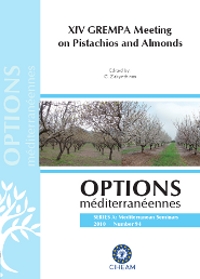| Article précédent | p. 221-228 | Article suivant |
Genetic diversity of pistachio in Tunisia
A research program is focus on protecting local genetic resources of pistachio and almond. The main traditional zones of pistachio crop in the centre and the south of Tunisia were prospected. Many specimens of Pistacia vera and Pistacia atlantica were investigated. Subsequently, local and foreign cultivars from collection were studied. Flowering time, nut futures and kernel quality were determined. Results obtained revealed interesting ecotypes behaviours and performances. For all the characteristics, great variability between ecotypes was observed. Differences were particularly important when flowering time and maturity period were considered. Nut futures revealed significant differences in P. vera nut weight which varied from 0.48 to 1.03 g. Blank and split rates were ranged respectively from 2 to 60 percent and from 14 to 95 percent. P. atlantica fruits fresh weights varied between 7.9 and 20 g for 100 fruits. Fat content of P. vera and P. atlantica ecotypes ranged between 56 and 78 percent DW and 40.45 and 48.2 percent DW respectively. Palmitic acid was the main saturated fatty acid, its content varied between 7.1 and 12.9 percent in P. vera and between 16.3 and 24.8 percent in P. atlantica. Oleic acid content ranged from 56.1 to 80.7 percent in P. vera with a significant difference over different ecotypes. For P. atlantica genotypes this latter fatty acid rates were ranged between 47.3 and 61 percent DW. Linoleic acid rate, varied between 8.2 and 29.7 percent DW in P. vera and was ranged between 17 and 19 percent DW in P. atlantica. Great variability was detected in P. atlantica germination capacity with extremes germination rates of 5 and 100 percent.
La richesse en écotypes locaux de pistachier a été étudiée dans un but de préservation des ressources génétiques locales. Un travail de prospection et de caractérisation a été mené dans les zones traditionnelles de production. Plusieurs spécimens de Pistacia vera et Pistacia atlantica ont été répertoriés. Ainsi une caractérisation phénologique et pomologique a été établie. Les résultats obtenus ont révélé un potentiel intéressant avec une grande variabilité pour les paramètres analysés. Le poids moyen d'un fruit a varié entre 0,48 et 1,03 g pour l'écotype de l'espèce P. vera et 0,079 et 0,2 g pour celui de P. atlantica. Les taux de fruits vides et déhiscents pour les spécimens cultivés ont été compris respectivement entre 2 et 60 pour cent et entre 14 et 95 pour cent. Ces écotypes locaux ont montré une richesse en huile des amandes dont la teneur a été de l'ordre de 56 à 78 pour cent et de 40,45 à 48,2 pour cent par rapport au poids sec. La composition acidique des huiles a révélé trois principaux acides : l'acide palmitique avec des teneurs comprises entre 7,1 pour cent et 12,9 pour cent pour P. vera et 16,3 et 24,8 pour cent pour P. atlantica, l'acide oléique de 56,1 pour cent à 80,7 pour cent pour P. vera et 47,3 à 61 pour cent pour P. atlantica et l'acide linoléique d'une teneur variant de 8,2 pour cent à 29,7 pour cent pour P. vera et 17 à 19 pour cent pour P. atlantica. De même, une grande variabilité a été observée pour la capacité germinative des fruits des spécimens de P. atlantica.
- [ Afficher ]
- [ Télécharger ]
- [ Exporter la citation ]
Vous pouvez télécharger la citation au format :
- [ Imprimer ]
-
Mots-clés
ACIDE GRAS, FLORAISON, HUILE D'AMANDE, PISTACIA ATLANTICA, PISTACIA VERA, VARIATION GENETIQUECiter cet article
Ghrab M., Zribi F., Chelli-Chaabouni A., Gouta H., Ben Mimoun M. Genetic diversity of pistachio in Tunisia. In : Zakynthinos G. (ed.). XIV GREMPA Meeting on Pistachios and Almonds. Zaragoza : CIHEAM / FAO / AUA / TEI Kalamatas / NAGREF, 2010. p. 221-228. (Options Méditerranéennes : Série A. Séminaires Méditerranéens; n. 94). 14. GREMPA Meeting on Pistachios and Almonds, 2008/03/30-2008/04/04, Athens (Greece). http://om.ciheam.org/om/pdf/a94/00801307.pdf



